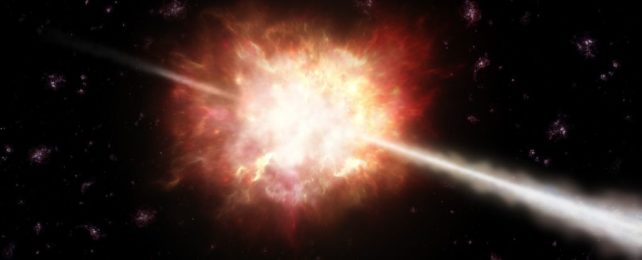Observatories around the world have just detected a colossal flare of extremely energetic radiation described as "record-breaking".
The event, first detected on October 9, was so bright that it was initially confused for an event closer to home. Initially dubbed Swift J1913.1+1946, it was thought to be a brief flash of X-rays from a not-too-distant source. It was only through further analysis that astronomers discovered the true nature of the glow – a gamma-ray burst, one of the most violent explosions in the Universe, now re-named GRB221009A.
Though further away, it was still one of the closest seen yet, just 2.4 billion light-years away. Moreover, this exceptionally bright gamma-ray burst appears to be the most energetic ever detected, coming in at up to 18 teraelectronvolts.
To be clear, though this proximity happens to be 20 times closer than the average long gamma-ray burst, it poses absolutely no danger to life on Earth.
Rather, it's tremendously exciting – an event that could shed new light (pun intended) on these fascinating explosions. Although its closeness makes it appear brighter in our sky, GRB221009A is possibly the most intrinsically bright gamma-ray burst we've ever seen.
"This is indeed a very exciting event!" astronomer and transient event specialist Gemma Anderson of the Curtin University node of The International Centre for Radio Astronomy Research (ICRAR) in Australia tells ScienceAlert.
"This event being so nearby but also very energetic means the radio, optical, X-ray and gamma-ray light it produces is extremely bright and therefore easy to observe. We can therefore study this GRB with lots of big and small telescopes around the world and collect very comprehensive datasets as it first brightens and then fades away."
On 2022-10-10 I observed the optical afterglow of the extremely bright GRB 221009A = Swift J1913.1+1946 remotely using telescope of Burke-Gaffney Observatory @smubgobs.
— Филипп Романов/Filipp Romanov (@romanov_filipp) October 10, 2022
Image: stacked 12x300 sec., Ic filter.
More information: https://t.co/sjocA0PCOo
@Astroguyz @El_Universo_Hoy pic.twitter.com/mSCKWZzkuI
Gamma radiation is the most energetic form of light in the Universe, produced by the radioactive decay of atomic nuclei. And a gamma-ray burst is an immense event, discharging in a few seconds as much energy as the Sun would produce in 10 billion years. These bursts mark the end of the life of a massive star – a supernova or hypernova. They can also emerge from a collision between two neutron stars.
Basically, when a star more massive than about eight of our Suns squished together runs out of material to fuel its hydrogen fusion, the outward pressure drops, and the star collapses under gravity. This produces a colossal explosion (the supernova), propelling the outer material into space, while the core collapses into a neutron star or black hole.
Different gamma-ray burst profiles mean different kinds of explosions, which fade in different ways. When astronomers observed a collision between two neutron stars in 2017, it produced a short gamma-ray burst. Long-duration bursts are associated with unusually powerful events, superluminous supernovae and hypernovae.
It's unclear, yet, what we're looking at with GRB221009A.
"It is still too early to tell," Anderson says. "The light from an underlying supernova will take days to brighten. However, given this gamma ray burst's long duration, it may be a very powerful type of supernova."
What we do know is that the burst appears to have emerged from a very dusty galaxy, and that it was very powerful. And the Large High Altitude Air Shower Observatory (LHAASO), a Cherenkov observatory in China, has detected photons with energies up to roughly 18 teraelectronvolts (TeV). To date, just a handful of gamma-ray bursts have been detected with emission in the TeV range; if the LHAASO data is verified, GRB221009A will be the first above 10 TeV.
There is, for now, a lot of science to be done in the days following the outburst. Scientists are training telescopes to the location of the object to observe the behavior of the afterglow across as many wavelengths as possible, information crucial to uncovering in detail the cause of the explosion.
"When you are dealing with cosmic explosions that blast out stellar remains at near the speed of light, leaving a black hole behind, you are watching physics occurring in the most extreme environments that are impossible to recreate on Earth," Anderson says.
"We still don't fully understand this process. Such a nearby explosion means we can collect very high quality data to study and understand how such explosions occur."
